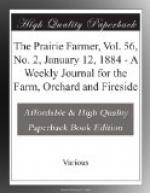QUESTIONS ANSWERED.
Glanders, Chronic Catarrh, and “Horse Distemper.”—H.P.W., Peotone, Ill.—Query—What are the symptoms whereby a person may know the difference between glanders, catarrh, and ordinary horse distemper?
Reply—Among the prominent symptoms of glanders may be mentioned a discharge of purulent matter from one or both nostrils; one or both glands on the inside of the lower jaw bones are more or less swollen, hard and knotty. One or both nostrils are sometimes swollen and glued up by a sticky, unhealthy looking pus, sometimes streaked with blood. On opening the nostrils, pustules and ulcers are seen on the inner surface. The nose may sometimes bleed. The eyes are often prominent and watery; the coat rough and staring if the horse is in lean condition; and the voice more or less hoarse. The appetite is not often impaired. Sooner or later, farcy buds may appear on the head, neck, body or limbs, generally along the inner side of the thighs. In chronic nasal catarrh or so-called gleet, the glands between the jaw bones are very slightly, if at all, enlarged; they are loose, not hard and knotty, as in glanders. This ailment, which is apt to persist for months, unless properly treated, may leave an animal in an unthrifty state, with a staring coat, disturbed appetite, dullness at work, cough and discharge from one or both nostrils; but there are no pustules or ragged sores or ulcers within the nose, as in glanders. Chronic nasal gleet, however, is apt to run into glanders; and, as there is no telling when the beginning is, such a horse, with chronic discharge from the nose, should always be looked upon with suspicion, and be kept away from other horses. The difference between glanders and influenza or ordinary horse distemper, is so marked that a mistake is not easily made. The more prominent symptoms of distemper are as follows: With signs more or less prominent of a general febrile condition, there is great dullness and debility, frequent and weak pulse, scanty discharge of high-colored urine, costiveness, loss of appetite, and a yellow appearance of the membranes of the mouth and the eyes. The eyes appear more or less sunken, upper lid drooping and lips hanging, giving the animal a sleepy look; there is cough, soreness of the throat, and labored breathing; the mouth is filled with frothy slime, the legs are cold and sometimes more or less swollen below the knees and hocks. In the advanced stages of distemper, there is a free discharge from both nostrils.
Brittle Hoofs.—I.F.C., Camden, Ill. If the animal is shod, the shoes should be removed and reset at least once a month, to allow the feet to be properly pared and trimmed. If habitually brittle, it will be proper to keep such feet off from much moisture, and instead provide dry floor of whatever kind. Once or twice a week such feet should be given an ample coat of some simple hoof ointment, such as equal parts of tar, tallow and beeswax, carefully melted together, and stirred till cold.




